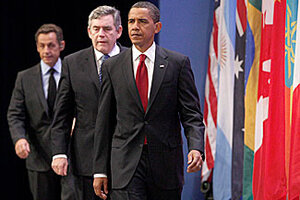Obama accuses Iran of secret nuclear facility
Ahead of G-20 meetings on Friday, Obama said the nuclear facility underscores Iran's 'continued unwillingness to meet its obligations' under international agreements.

US President Barack Obama, followed by British Prime Minister Gordon Brown and French President Nicolas Sarkozy, enters a news conference at the Pittsburgh G20 Summit Friday.
Jim Young/Reuters
President Obama announced Friday that Iran has been building a covert uranium-enhancement facility whose size and configuration is "inconsistent" with a domestic nuclear power program.
Mr. Obama appeared before cameras with the leaders of Britain and France prior to meetings of the Group of 20 nations in Pittsburgh. The existence of this secret plan, he said, underscores Iran's "continued unwillingness to meet its obligations" under international agreements governing development of peaceful nuclear programs.
To many in the West, revelations about this buried plant may stand as further proof that Iran wants an arsenal of nuclear weapons. If nothing else, the shock announcement may make it easier for the United Nations Security Council to impose yet tougher economic sanctions on Iran – especially if Iranian leaders block inspection of the suspect site.
"The level of deception by the Iranian government ... will shock the international community," British Prime Minister Gordon Brown said.
According to US officials, the covert uranium-enrichment plant is located about 100 miles southwest of Tehran and is underground. They said it contains about 3,000 centrifuges – tall tubes that spin at high speed to separate uranium gas into its different isotopes.
By feeding the gas through a series of the tubes, operators would gradually increase concentration of the isotope U-235, which is unique in its ability to cause a rapidly expanding fissile chain reaction. Natural uranium has about only 1 percent U-235; enriched uranium suitable for weapons has about 20 percent U-235.
A piece of U-235 about the size of a grain of rice contains the same amount of energy found in three tons of coal.
Iran already had one acknowledged enrichment plant, near the town of Natanz. A second such plant would make it harder for any military action to destroy Iranian nuclear-development capability. It could also speed the day when Tehran would have enough stockpiled fissile material for a substantial nuclear weapons program.
Iran has denied allegations that it has worked toward making nuclear weapons, saying that it wants to develop a domestic nuclear power industry. Its Natanz site is under UN surveillance.
Western intelligence agencies apparently have known about the secret site for some time. They decided to go public with their knowledge after Iran found out that other nations knew of the hidden facility.
Tehran confirmed the existence of the second enrichment site in a Monday letter to Mohamed ElBaradei, head of the International Atomic Energy Agency.
Iran and six world powers were already scheduled to meet Oct. 1.
Now, those talks will almost certainly be infused with tension. French President Nicolas Sarkozy said Friday that Iran has until December to comply with UN demands for further inspections.
"Everything, everything must be put on the table now," said Mr. Sarkozy.
